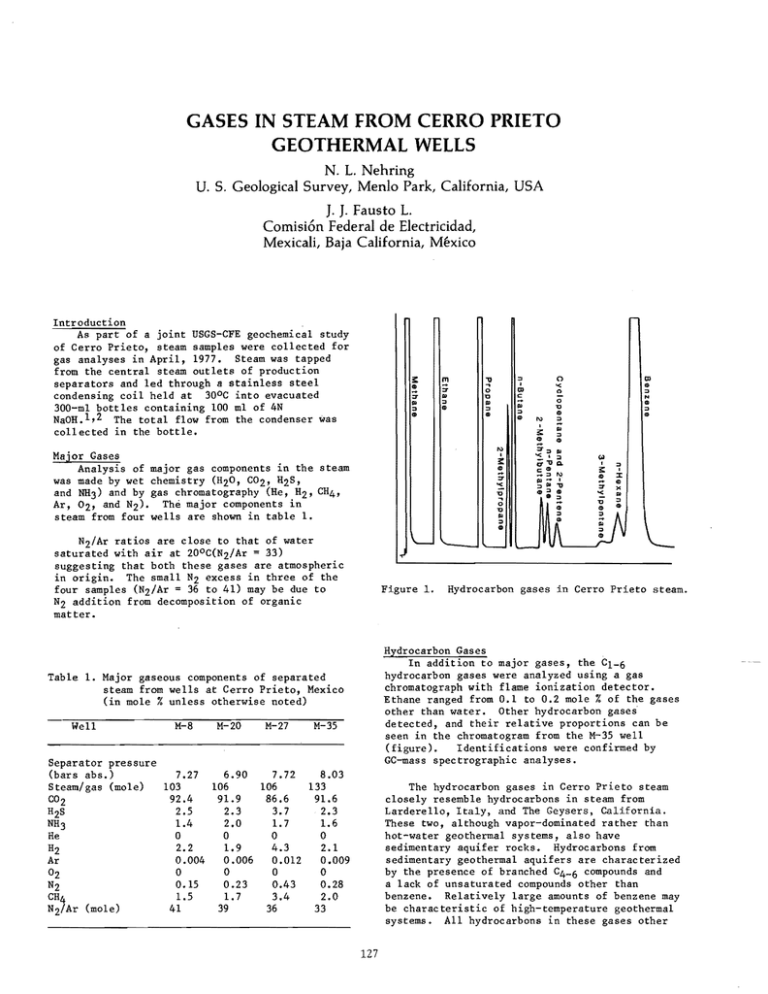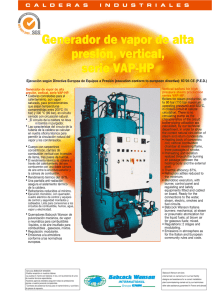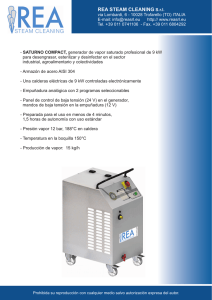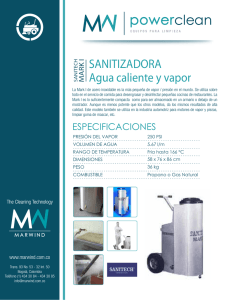GASES IN STEAM FROM CERRO PRIETO GEOTHERMAL WELLS
Anuncio

GASES IN STEAM FROM CERRO PRIETO GEOTHERMAL WELLS N. 1. Nehring
U. S. Geological Survey, Menlo Park, California, USA
J. J. Fausto 1. Comision Federal de Electricidad, Mexicali, Baja California, Mexico Introduction
As part of a joint USGS-CFE geochemical study
of Cerro Prieto, steam samples were collected for
gas analyses in April, 1977. Steam was tapped
from the central steam outlets of production
separators and led through a stainless steel
condensing coil held at 30 0 C into evacuated
300-ml bottles containing 100 ml of 4N
NaOH.l,Z The total flow from the condenser was
collected in the bottle.
l!:
!::r
III
'"
I\)
m
;
III
'"
I\)
'",
"...
;;
'"
..
'"
I\)
Major Gases
Analysis of major gas components in the steam
was made by wet chemistry (HZO, COZ, HZS,
and NH3) and by gas chromatography (He, HZ, CH4,
Ar, OZ, and NZ)' The major components in
steam from four wells are shown in table 1.
I
I\)
::r
'<
...
'D
0
'0
III
.
I\)
()
'"
0
'D
I\)
'"
I\)
I\)
,
..
~
'"~
01
0
'<
01
c
0
'D
III
::r '"
~,
I\)
:.
III
'"
I\)
III
~
...c .."~
~'"
I\)
"~I
'" III "
lI>"'tID
.. ::>
,
(.>
~
I\)
::r
'<
'"
I
:I:
I\)
)(
III
'"
II>
'"
II>
NZ/Ar ratios are close to that of water
saturated with air at ZOOC(NZ/Ar = 33)
suggesting that both these gases are atmospheric
in origin. The small NZ excess in three of the
four samples (NZ/Ar = 36 to 41) may be due to
NZ addition from decomposition of organic
matter.
Figure 1.
Hydrocarbon Gases
In addition to major gases, the Cl-6
hydrocarbon gases were analyzed using a gas
chromatograph with flame ionization detector.
Ethane ranged from 0.1 to 0.2 mole % of the gases
other than water. Other hydrocarbon gases'
detected, and their relative proportions can be
seen in the chromatogram from the M-35 well
(figure).
Identifications were confirmed by
GC-mass spectrographic analyses.
Table 1. Major gaseous components of separated
steam from wells at Cerro Prieto, Mexico
(in mole % unless otherwise noted)
Well
M-8
M-ZO
M-Z7
Hydrocarbon gases in Cerro Prieto steam.
M-35
Separator pressure
(bars abs.)
8.03
7.72
7.Z7
6.90
Steam/gas (mole)
103
106
106
133
86.6
91.6
91.9
92.4
COZ
Z.5
Z.3
3.7
Z.3
HZS
Z.O
1.6
1.4
1.7
NH3
He
0
0
0
0
4.3
Z.1
Z.Z
1.9
HZ
0.006
0.012
0.009
Ar
0.004
0
0
0
0
°z
0.15
0.23
0.43
0.28
N2
1.7
1.5
3.4
2.0 CH;
41
39
36
33 NZ Ar (mole)
The hydrocarbon gases in Cerro Prieto steam closely resemble hydrocarbons in steam from Larderello, Italy, and The Geysers, California. These two, although vapor-dominated rather than hot-water geothermal systems, also have sedimentary aquifer rocks. Hydrocarbons from sedimentary geothermal aquifers are characterized by the presence of branched C4-6 compounds and a lack of unsaturated compounds other than benzene. Relatively large amounts of benzene may be characteristic of high-temperature geothermal systems. All hydrocarbons in these gases other 127 128
than methane most probably originate from the
thermal metamorphosis of organic matter contained
in the sediments. Methane probably originates
predominantly from the reaction of hydrogen and
C02 in the presence of liquid water 3 •
Steam/Gas Measurements
Two methods were compared in determining
steam/gas ratios. The laboratory (or total flow)
method was discussed above. Each component can
be determined independently from other components
and without loss during collection, making this
an exact method; but it is time consuming and
requires proper equipment and technique.
A field method employed a 500-ml bottle with
a tube at each end. Alternate displacement of
gas by condensate and vice versa was timed with a
stopwatch. The mechanical problems of this and
other field measurements of steam/gas ratios have
been discussed by Nehring and Truesdell l , but
there are chemical problems as well. The field
methods do not measure the quantity of gas
dissolved in the condensate, which can amount to
50% of the gas in some instances. The separation
of gas and condensed steam into discrete phases
occurs in the condenser at some pressure between
atmospheric and that of the production
separator. Calculations in Table 2, based on
these two pressure extremes, show that agreement
with the laboratory method is only obtained by
assuming that condensed steam and gas were in
equilibrium at some intermediate pressure.
Used without corrections, the field method
seriously underestimates the amount of gas in the
steam only, and corrections are at best
approximate. We strongly recommend the
collection of total flow samples with
determination of steam/gas ratios in the
laboratory.
Work partially supported by U.S. Department
of Energy.
Table 2.
Comparison of steam/gas (molar) ratio
measurements
Well
Separator pressure
(bars absolute)
M-8
7.27
M-20
6.90
M-27
7.72
M-35
8.03
Laboratory
steam/gas
103
106
106
133
Field
steam/gas
210
187
124
277
Field steam/gas
corrected to
separator pressure
and 30 0 C
88
89
67
106
135
98
175
Field steam/gas
corrected to
1 atm and 30 0 C
145
References
1. Nehring, N. L., and Truesdell, A. H., 1978,
Collection of chemical, isotope and gas
samples from geothermal wells: Proceedings
of the Second Workshop on Sampling Geothermal
Effluents, Las Vegas, February, 1977, United
States Environmental Protection Agency Report
EPA-600/7-78-l2l, pp. 130-140.
2. Giggenbach, W. F., 1975, A simple method for
collection and analysis of volcanic gas
samples: Bull. Volcanol., v. 39,
pp. 132-145.
3. Ellis, A. J., 1957, Chemical equilibrium in
magmatic gases, Am. J. Sci., v. 255,
pp. 416-431.
LOS GASES EN EL VAPOR DE POZOS GEOTERMICOS DE CERRO PRIETO Introduccion
Gases Principales
Como parte de un estudio geoqufmico de Cerro
Prieto, llevado a cabo conjuntamente entre USGS y
CFE, en abril de 1977, se recolectaron muestras de
vapor para hacer analisis de gases. Las muestras
fueron tomadas de las salidas de vapor centrales
de los separadores de produccion y conducidas a
traves de una bob ina condensadora de acero inoxi­
dable mantenida a 30 0 c hasta frascos evacuados de
300 ml que contenfan 100 ml de NaOH 4N 1,2. Se
recolecto en el frasco el flujo total del conden­
sador.
Se analizaron los principales componentes de
gas en el vapor por medio de qu!mica humeda (H20,
C02, H2S, y NH3) Y por cromatograf!a de gas
(He, H2' CH4' Ar, 02 y N2)' En la tabla 1
aparecen los principales componentes del vapor
correspondiente a cuatro pozos.
Las razones N2/Ar se aproximan a la del agua
saturada con aire a 200C(N2/Ar = 33), 10 que su­
giere que ambos gases son de origen atmosferico.
El pequeno exceso de N2 en tres de las cuatro
129 muestras (Nz/Ar = 36 a 41) puede deberse a una adi­
cion de NZ proveniente de la descomposicion de ma­
teria organica.
Hidrocarburos Gaseosos
Ademas de los gases principales se analizaron
los hidrocarburos gaseosos Cl-6' por medio de un
cromatografo de gas con detector de ionizaci6n de
llama. En etano osci16 de 0.1 a 0.2 moles % de
los gases excluyendo el agua. Se pueden apreciar
otros hidrocarburos gaseosos detectados y sus pro­
porciones relativas en la cromatografia del pozo
M-35 (Figura). Se confirmaron las identificacio­
nes por medio de analisis espectrograficos de
cromatografia gaseosa de masa.
Los hidrocarburos gaseosos en el vapor de
Cerro Prieto se asemejan mucho a los hidrocarbu­
ros presentes en el vapor de Larderello, Italia y
The Geysers, California. Estos ultimos, aunque
son sistemas dominados por vapor en vez de sis­
temas geotermicos de agua caliente, tambien tie­
nen rocas de acu1fero sedimentarias. Los hidro­
carburos de acu!feros geotermicos sedimentarios
se caracterizan por la presencia de compuestos
C4-6 ramificados y por la falta de compuestos no
saturados, con la excepcion del benceno. Las
cantidades relativamente grandes de benceno pue­
den ser carateristicas de sistemas geotermicos de
alta temperatura. Todos los hidrocarburos conte­
nidos en estos gases, con excepcion del metano, se
originan probablemente en la metamorfosis termica
de la materia organica contenida en los sedimen­
tos. Es probable que el metano provenga predomi­
nantemente de la reaccion entre hidrogeno y C02
en presencia de agua 1{quida3 •
Medidas Gas/Vapor
Se compararon dos metodos en la determinaci6n
de las razones vapor/gas. El metoda de laborato­
rio (0 de flujo total) se discutio anteriormente.
Cad a componente puede determinarse independiente­
mente de los otros componentes y sin perdida du­
rante la recoleccion, 10 que 10 hace un metodo
exacto; pero es muy laborioso y requiere disponer
de equipo y tecnica apropiados.
En el metoda de campo se emple6 un frasco de
500 ml con un tubo en cada extremo. Se midio con
un cron6metro el desplazamiento alternativo del
gas por condensado y vice versa. Los problemas
mecanicos de esta y otras medidas de campo de las
razones vapor/gas han sido discutidos por Nehring
y Truesdell l , perc existen tambi~n problemas
qu1micos. Los metodos de campo no miden la canti­
dad de gas disuelto en el condensado, que puede
ser de hasta 50% del gas en algunos casos. La se­
paracion del gas y vapor condensado en fases dis­
cretas tiene lugar en el condensador a cierta pre­
sion intermedia entre la atmosferica y la del se­
parador de produccion. Los calculos de la Tabla
2, basados en dichos extremos de presion demues­
tran que para obtener acuerdo con el metodo de
laboratorio es necesario suponer que el gas y el
vapor condensado alcanzan equilibrio a alguna pre­
sion intermedia.
Utilizado sin correcciones, el metodo de camp'
subestima seriamente la cantidad de gas presente
en el vapor unicamente, y las correcciones son, en
el mejor de los casos, aproximadas. Recomendamos
particularmente la recoleccion de muestras de flu­
jo total y la determinacion de razones vapor/gas
en el laboratorio.
Titulo de Figura
Figura 1. Hidrocarburos gaseosos en vapor de
Cerro Prieto.
Titulo de Tabla
Tabla 1. Componentes gaseosos principales de va­
por separado de pozos en Cerro Prieto, Mexico (en
% de mol a menos que se indique otra cosa).






